Sensor Fabrication Method for in Situ Temperature and Humidity Monitoring of Light Emitting Diodes
Abstract
:1. Introduction
2. Methodology
2.1. Theory of Micro Temperature Sensor
2.2. Theory of Micro Humidity Sensor
3. Fabrication of Flexible Micro Sensors
4. Results and Discussion
5. Conclusions
Acknowledgments
References
- Weng, C.J. Advanced thermal enhancement and management of LED packages. Int. Commun. Heat Mass. Trans 2009, 36, 245–248. [Google Scholar]
- Lu, X.Y.; Hua, T.C.; Liu, M.J.; Cheng, Y.X. Thermal analysis of loop heat pipe used for high-power LED. Thermochim. Acta 2009, 493, 25–29. [Google Scholar]
- Cheng, Y.W.; Chen, H.H.; Ke, M.Y.; Cheng, C.P.; Huang, J.J. Effect of selective ion-implanted p-GaN on the junction temperature of GaN-based light emitting diodes. Opt. Commun 2009, 282, 835–838. [Google Scholar]
- Senawiratne, J.; Li, Y.; Zhu, M.; Xia, Y.; Zhao, W.; Detchprohm, T.; Chatterjee, A.; Plawsky, J.L.; Wetzel, C. Junction temperature measurements and thermal modeling of GaInN/GaN quantum well light-emitting diodes. J. Electron. Mater 2008, 37, 607–610. [Google Scholar]
- Hu, J.; Yang, L.; Shin, M.W. Mechanism and thermal effect of delamination in light-emitting diode packages. Microelectr. J 2007, 38, 157–163. [Google Scholar]
- Tan, C.M.; Chen, B.K.E.; Xu, G.; Liu, Y. Analysis of humidity effects on the degradation of high-power white LEDs. Microelectron. Rel 2009, 49, 1226–1230. [Google Scholar]
- Lee, C.Y.; Wu, G.W.; Hsieh, W.J. Fabrication of micro sensors on a flexible substrate. Sensor. Actuat. A 2008, 147, 173–176. [Google Scholar]
- Lee, C.Y.; Hsieh, W.J.; Wu, G.W. Embedded flexible micro-sensors in MEA for measuring temperature and humidity in a micro-fuel cell. J. Power Sources 2008, 181, 237–243. [Google Scholar]
- Lee, C.Y.; Su, A.; Liu, Y.C.; Fan, W.Y.; Hsieh, W.J. In situ measurement of the junction temperature of light emitting diodes using a flexible micro temperature sensor. Sensors 2009, 9, 5068–5075. [Google Scholar]
- Uchida, H.; Yamashita, M.; Hanaki, S.; Ueta, T. Characterization of (Ti, Al) N films prepared by ion mixing and vapor deposition. Mater. Sci. Eng. A 2004, 387–389, 758–762. [Google Scholar]
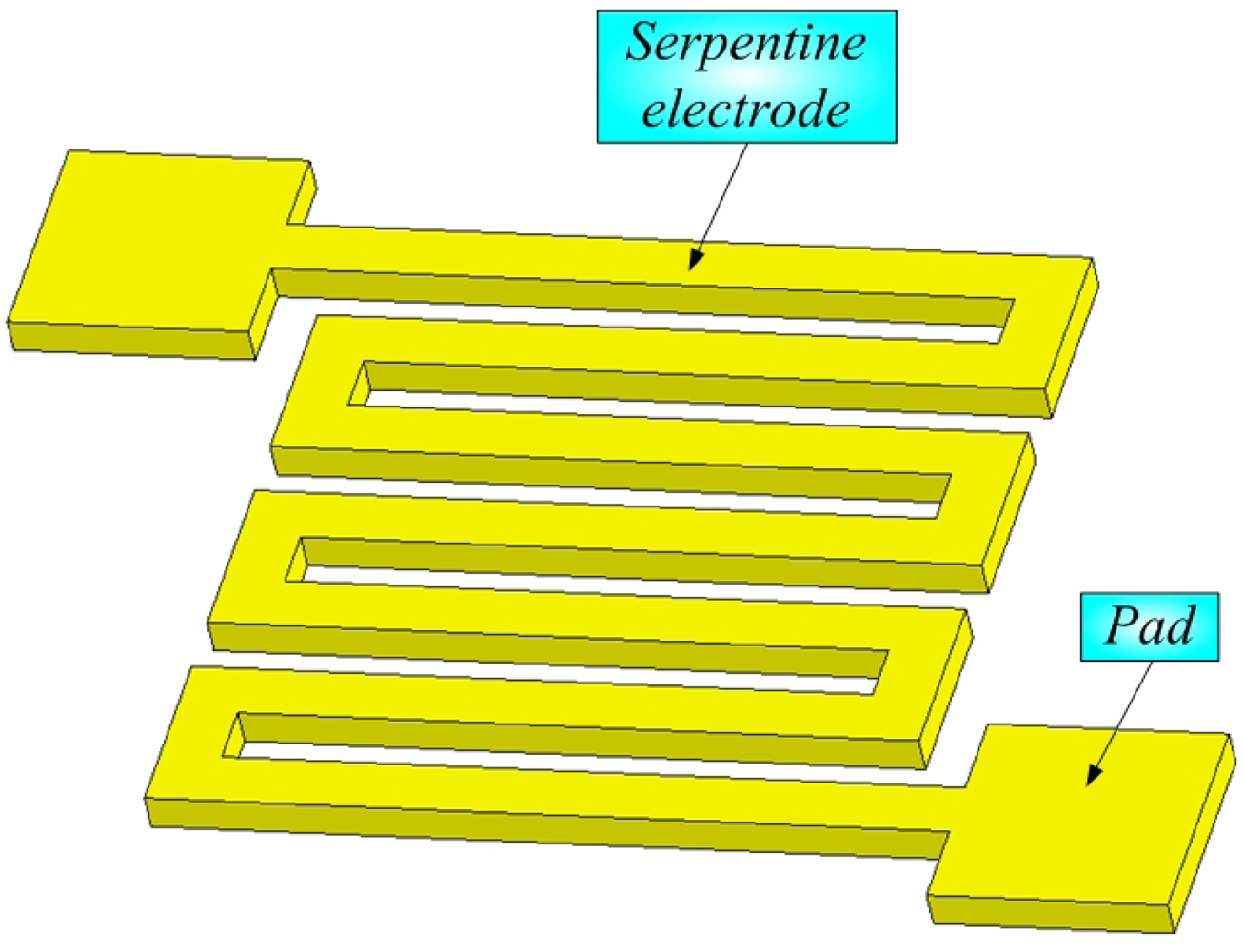

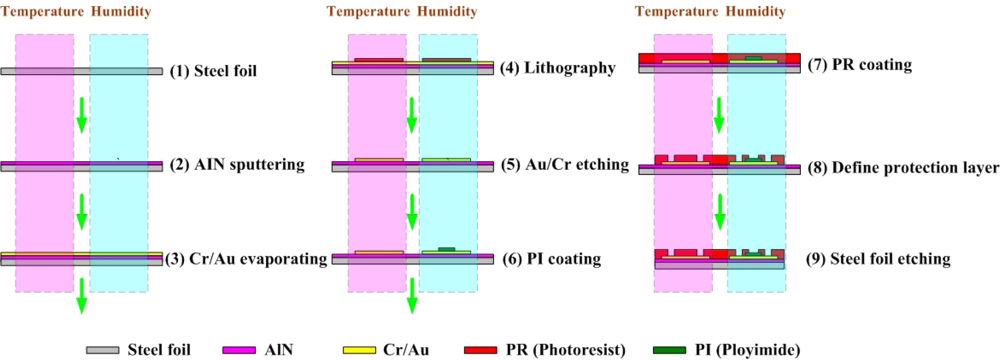
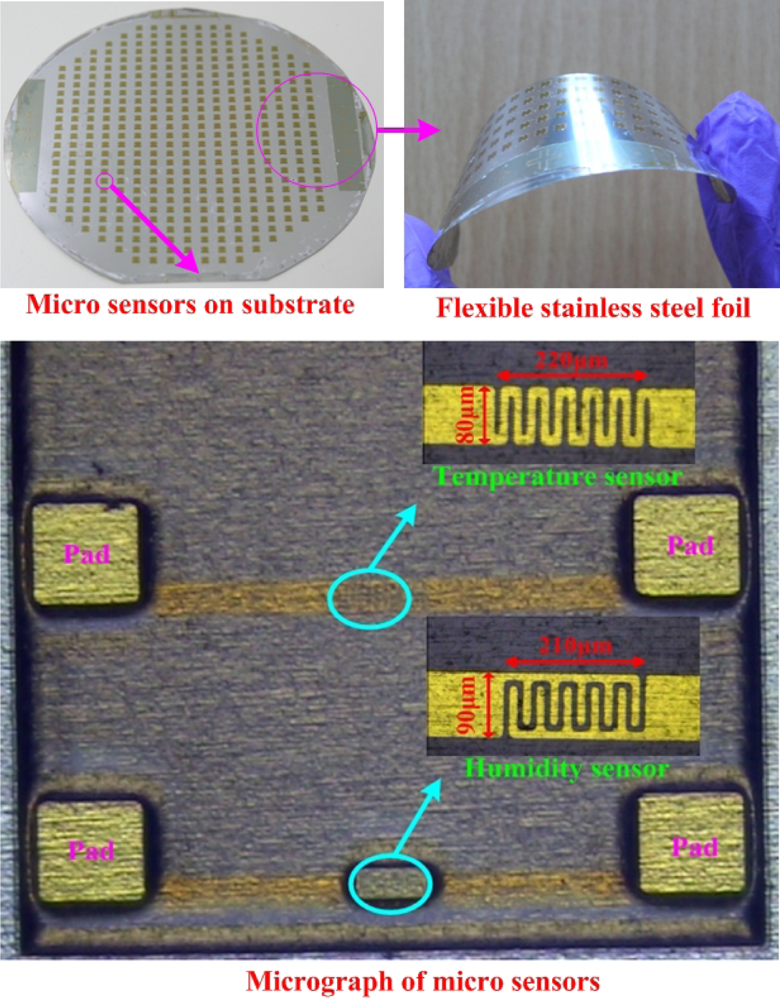
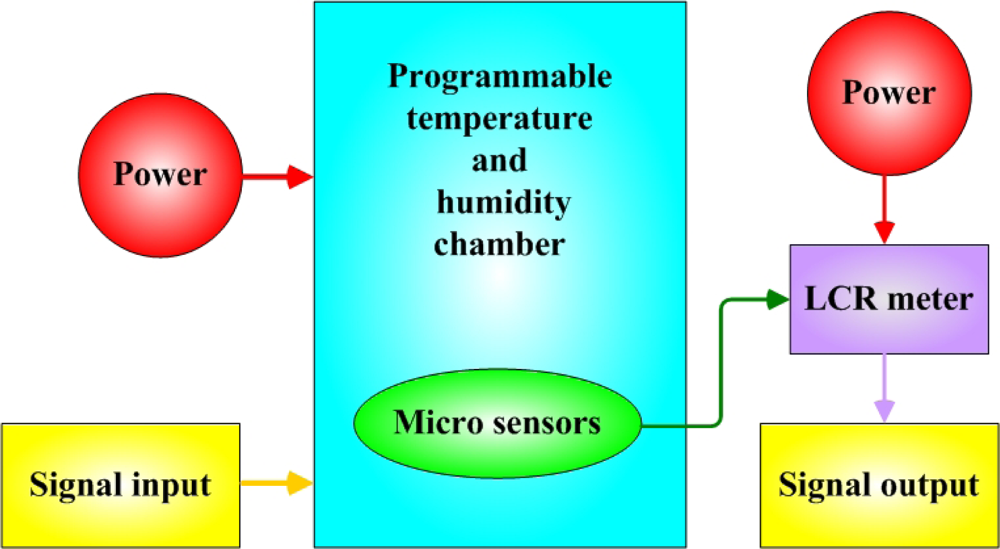
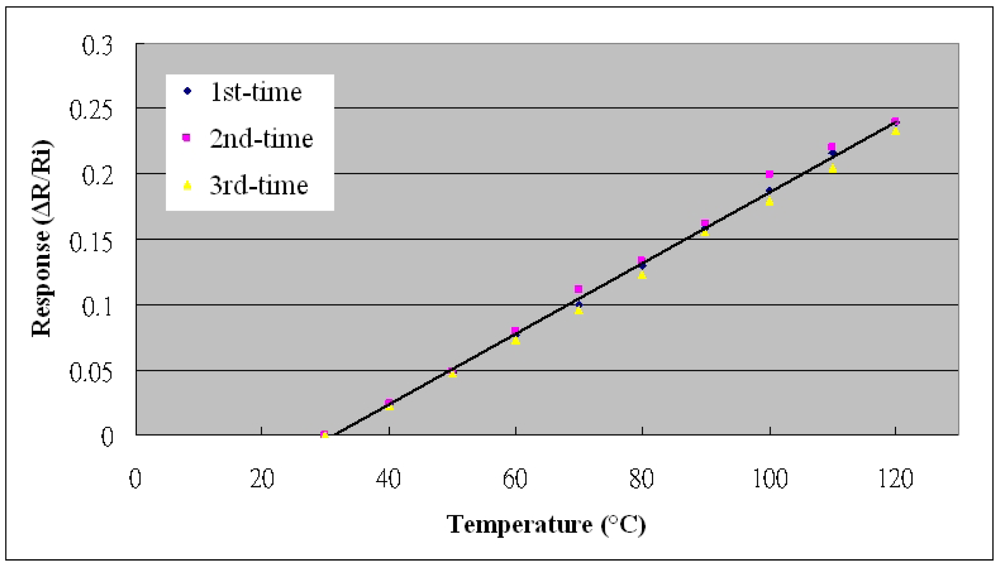
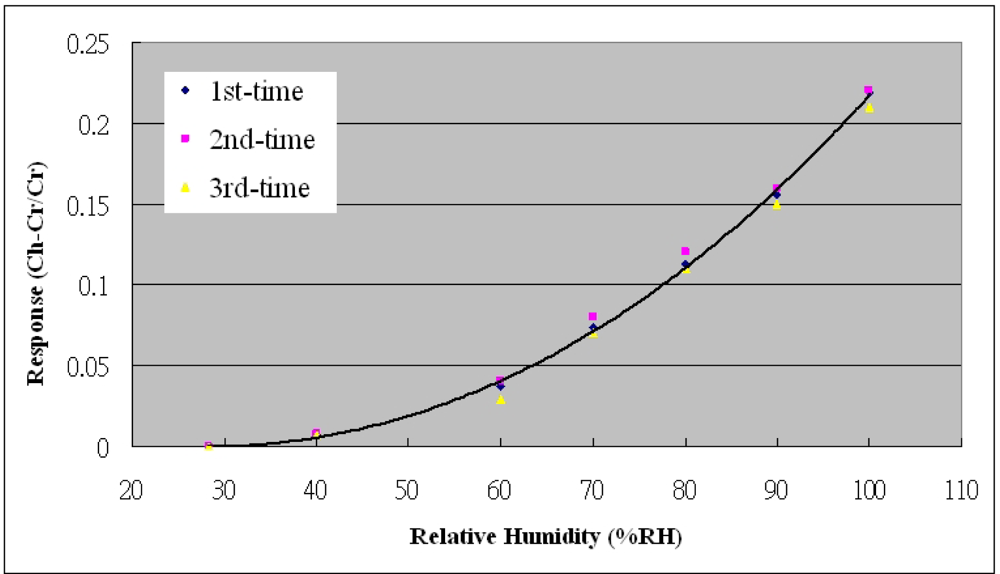

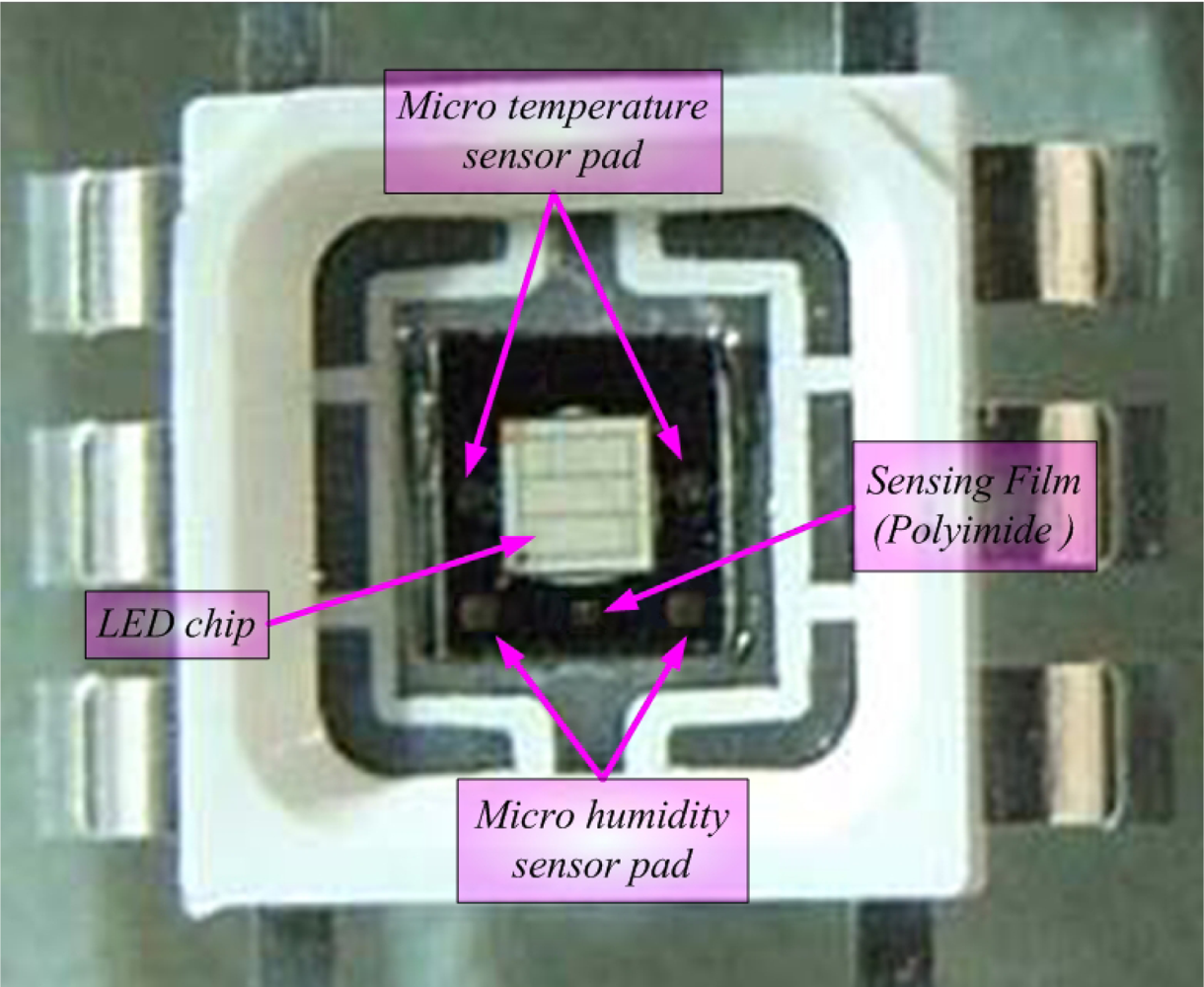
| STEP | RECIPE |
|---|---|
| (1) | Steel foil: stainless steel foil substrate (SS-304 40 μm thick) H2SO4 + H2O2 (cleaning 10 mins) |
| (2) | AlN sputtering: Ar (8SCCM), N2 (2SCCM), pressure (0.32 Pa), substrate temperature (120 °C), power (170 W) |
| (3) | Cr / Au evaporating: substrate temperature (100 °C), background pressure (7 × 10−7Torr), Cr thickness (200 Å), Au thickness (2,000 Å) |
| (4) | Lithography: spin-coated photoresist→ step1:500 rpm, 5s; step2:3,000 rpm, 30 s. soft bake→ 90 °C, 120 s. exposure→ 5 mW/cm2. development→ MF319:DI water = 1:1, hard bake→ 90 °C, 300 s |
| (5) | Au / Cr etching: Au etching (KI + I2,7 mins), Cr etching (Cr-7, 3 mins) |
| (6) | PI coating: spin-coated polyimide→ step1:500 rpm, 5s; step2:3,000 rpm, 30s. soft bake→ 90 °C, 120 s. exposure→ 5 mW/cm2. development→ (HTR D-2):(RER 600) = 1:2, hard bake→ 90 °C, 300 s |
| (7) | PR coating: spin-coated photoresist→ step1:500 rpm, 5 s; step2:3,000 rpm, 30 s. soft bake→ 90 °C, 120 s. |
| (8) | Define protection layer: exposure→ 5m W/cm2. development→ MF319:DI water = 1:1, hard bake→ 90 °C, 300 s |
| (9) | Steel foil etching: aqua regia (50 °C) |
| Operating current (mA) | Micro temperature sensor | Thermal resistance measurement |
|---|---|---|
| Temperature (°C) | Temperature (°C) | |
| 0 | 25.46 | 25.3 |
| 60 | 36.14 | 35.1 |
| 120 | 45.32 | 43.8 |
| 180 | 56.20 | 53.1 |
| 240 | 66.02 | 62.5 |
| 300 | 76.06 | 71.6 |
| 350 | 85.45 | 80.0 |
© 2010 by the authors; licensee Molecular Diversity Preservation International, Basel, Switzerland. This article is an open-access article distributed under the terms and conditions of the Creative Commons Attribution license ( http://creativecommons.org/licenses/by/3.0/).
Share and Cite
Lee, C.-Y.; Su, A.; Liu, Y.-C.; Chan, P.-C.; Lin, C.-H. Sensor Fabrication Method for in Situ Temperature and Humidity Monitoring of Light Emitting Diodes. Sensors 2010, 10, 3363-3372. https://doi.org/10.3390/s100403363
Lee C-Y, Su A, Liu Y-C, Chan P-C, Lin C-H. Sensor Fabrication Method for in Situ Temperature and Humidity Monitoring of Light Emitting Diodes. Sensors. 2010; 10(4):3363-3372. https://doi.org/10.3390/s100403363
Chicago/Turabian StyleLee, Chi-Yuan, Ay Su, Yin-Chieh Liu, Pin-Cheng Chan, and Chia-Hung Lin. 2010. "Sensor Fabrication Method for in Situ Temperature and Humidity Monitoring of Light Emitting Diodes" Sensors 10, no. 4: 3363-3372. https://doi.org/10.3390/s100403363





